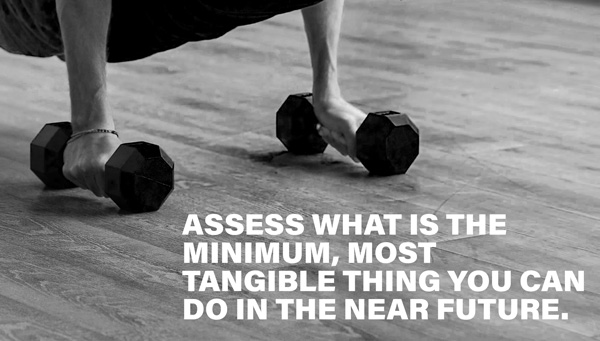Whether you’re coming back to the gym after lockdown or are a newbie to the whole fitness lifestyle, restarting or just plain starting from scratch can quickly feel daunting. That once powerful motivation and habitual exercise practice of showing up and putting in the work now seems like a lifetime ago.
Now, just the mere thought of getting our shoes tied and heading out to the gym, track, or anywhere that demands us to become active, organized, and purposeful regarding our health makes us want to simply tell ourselves that we’ll start next week.
How do we restart our best fitness efforts? How do we even fathom the thought of starting over when all we’ve done is binged our favorite shows, participated in endless Zoom meetings, and dreamed of getting back to “normal?”
There are realistic, simple, and manageable ways to kickstart our exercise goals once more. In order to accomplish such a task we’ll need to establish a starting point before we can think of the finish line.
Which exercise starter are you?
First, let’s establish where you currently sit on the fitness spectrum.
Are you a newbie to exercise?
If so, this is a brand new endeavor for you. It’s likely you have little idea how to start effectively and may feel a little lost. Fear not. Many of the same rules apply. The only difference may be the learning curve. You may need a bit more time to master exercises, develop lasting habits, and acclimate to the new tempo of your daily schedule.
One thing to consider is to start with a positive mindset. Try to avoid the trap of overwhelm and negative thinking. You’re about to embark on a transformative journey that will hopefully seamlessly integrate with your life in so many positive ways. Don’t build your own walls.
Are you coming back from a layoff?
Maybe you’ve found yourself caught up in the stereotypical deluge of pandemic life; working from home, sporadic schedules, and unorganized days and nights.
Here’s the good news regarding starting over: you’ve been here and have done this before. You know what it’s like to do the work, live the fitness lifestyle, and see real, tangible results. Yes, it may take some time to kick off the rust and get moving again, but your learning curve is a bit shorter thanks to muscle memory.

You might, however, need a swift kick in the pants to get things going again. You’ve been in a motivational moratorium and it’s time to lift the curtain and restart toward progress once more.
Steps to restart your fitness
It’s best to take things step by step, to break things down into tangible, realistic pieces so as to avoid inundating yourself with too many tasks and to ultimately put you on the right path to efficiency, effectiveness, and success. Take some time with each step below. Sit down and be honest with yourself when making your plan. You’ll be taking deliberate action once you’re ready to restart so be prepared to commit.
Choose a realistic goal
You don’t need to be a PhD. in exercise physiology or dietetics to scan certain things through your B.S. meter. For example, losing 50 pounds of body fat in one month isn’t all that realistic. Anyone can detect that. Start small. Is five pounds in a month doable? Sure it is. That’s roughly a pound per week.
The important part is to nail down a short term goal, something that will grant you a small, quick win and cultivate significant momentum. This will only fuel your motivation further, plus these short goals will add up over time. Self-discipline, motivation, consistency are all similar to muscle tissue. They take time to develop to optimal levels. You don’t run a marathon out of the gate. You start with maybe one mile and add a little more each week or so over time.

Set a real-world plan
You’ll need to take several factors into consideration while formulating your plan.
- What does your current schedule allow for regarding training, eating, and sleep?
- How many days per week, time per day, and availability/access of a gym/fitness facility can you commit to?
A good rule of thumb is to start with some “low hanging fruit” to begin. Assess what is the minimum, most tangible thing you can do in the near future. Is it to commit to three days per week, 30 minutes per day? Go with that.
The key is to establish a solid starting point and to not worry if you think it’s too little of an effort. Start small and add on as time, availability, and fitness level allow.
Write it down/journal
We as human beings heavily rely on sight for nearly everything in life. The more information we can process with our eyes the more we observe and understand. This is why journaling is so effective. When we see what we’ve experienced or read our own written words from our thoughts it becomes more impactful. It conjures a more comprehensive understanding of what we are going through or want to accomplish.
Fitness is no different.
Write down your training plan, diet habits, motivational levels, and anything else that you feel is impacting your progress. Keeping a daily record of these important points will not only keep your head in the game and motivate you to stay on track, it’ll also reveal things that may otherwise get unnoticed such as what’s working well and what isn’t.

Assess but don’t reinvent
With the above practices firmly adopted, now you can assess what needs improvement. Here, however, is where you can easily get sidetracked with trying to reinvent the wheel. We are so apt to constantly overhaul our plans when something isn’t quite working as well as we’d hoped. We “program hop” too often resulting in us not ever seeing any significant outcomes. We never give anything a chance long enough to see change.
If you do see something in your notes that needs shifting, only change that one thing and give it plenty of time to make a difference. In other words, changing too many factors will guarantee that you’ll never know what exactly is working and what isn’t. One thing at a time.
Stumble but don’t fall
Have you ever started something only to be faced with obstacles right off the bat? For some, that makes them want to quit altogether. Eventually they find themselves in a perpetual restart state until they drop their plan due to burnout.
We will all stumble along our journeys. We will all have to surmount roadblocks, proverbial walls, and life’s setbacks at one point or another. But the most important thing we can do is to get back up and keep going. To start back where we left off without giving ourselves a moment to look back or be disappointed.
The easier road, the road to nowhere, is to simply quit–to vaguely tell ourselves that we will just commit to some nonexistent future date that doesn’t require us to seriously act and become accountable.
If you stumble, keep looking forward, restart that momentum without flinching, and set the stage for success once more.
Need an exercise regimen to get started?
- Science Determined The Perfect Home Bodyweight Workout & It Only Takes 7 Minutes
- 20 Minute Burners: Maximum Results in Little Time
- Train Like a Warrior: The Air Force Spec Ops-Inspired Workout
- Big Lifts Big Progress
In closing
Restarting your fitness aspirations doesn’t have to be so daunting. With carefully planned steps, an honest self assessment, and solid commitment you’ll be armed with the right tools for success. Remember to set realistic goals, devise a solid plan of action, write it all down daily, assess what’s working and what isn’t, and finally defend yourself from discouragement when things go sideways. It’s time for you to get back on track, pandemic or not.
















